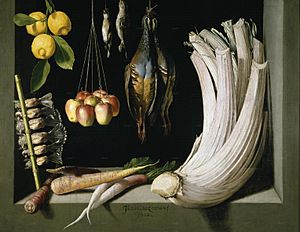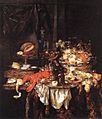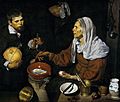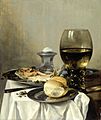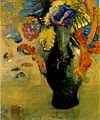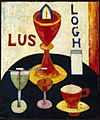Still life facts for kids
A still life (plural: still lifes) is a type of work of art that shows mostly objects that don't move or aren't alive. These are usually everyday things you might see around you. They can be natural items like food, flowers, plants, rocks, or shells. They can also be man-made objects such as drinking glasses, books, vases, or jewelry.
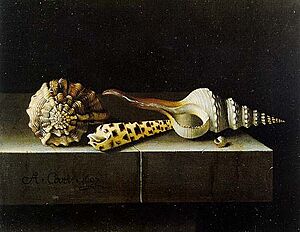
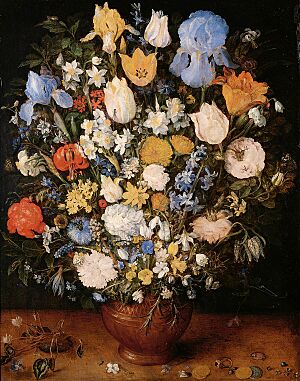
Still life art has roots in ancient Greek and Roman times and the Middle Ages. But it really became its own special type of painting in Western art by the late 1500s. It has been important ever since. One cool thing about still life is that artists have a lot of freedom. They can arrange the objects in many different ways to create their painting. The English term still life comes from the Dutch word stilleven.
Early still life paintings, especially before the 1700s, often had hidden meanings. They used objects to represent religious ideas or stories. Later, artists started using new ways to create still life art. This includes using found objects, photography, computer graphics, and even video and sound.
Still life paintings sometimes look like plant or animal drawings. But in fine art, the goal is not just to show the subject perfectly. It's about the artist's view and arrangement.
Even though still life was once seen as a less important type of art, people loved to buy it. Besides paintings that are only still life, this art style also appears in other types of paintings. Often, the still life parts have a special meaning. For example, a trompe-l'œil painting is a special kind of still life. It tries to trick your eye into thinking the objects are real.
Images for kids
-
Édouard Manet, Carnations and Clematis in a Crystal Vase (1883)
-
Still life on a 2nd-century mosaic, with fish, poultry, dates and vegetables from the Vatican museum
-
Hans Memling (1430–1494), Vase of Flowers (1480), Museo Thyssen-Bornemisza, Madrid. Some experts believe the flowers have religious meanings.
-
Jacopo da Empoli (Jacopo Chimenti), Still life (c. 1625)
-
Willem Kalf (1619–1693), oil on canvas, The J. Paul Getty Museum
-
Pieter Claesz (1597–1660), Still life with Musical Instruments (1623)
-
Jan Philip van Thielen (1618–1667), Vase of Flowers (c. 1660), Fitzwilliam Museum, Cambridge, England
-
Diego Velázquez, Old Woman Frying Eggs (1618), (National Gallery of Scotland), an early example of a bodegón (a Spanish still life often showing kitchen scenes).
-
Francisco de Zurbarán, Bodegón or Still Life with Pottery Jars (1636), Museo del Prado, Madrid
-
Josefa de Ayala (Josefa de Óbidos), Still-life (c. 1679), Santarém, Municipal Library
-
Luis Egidio Meléndez (1716–1780), Still Life with Apples, Grapes, Melons, Bread, Jug and Bottle
-
Vincent van Gogh (1853–1890), Sunflowers or Vase with Fifteen Sunflowers (1888), National Gallery (London)
-
Jean Metzinger, Fruit and a Jug on a Table (1916), oil and sand on canvas, Museum of Fine Arts, Boston
-
Giorgio Morandi (1890–1964), Natura Morta (1956), oil on canvas, private collection
-
A completely synthetic, computer generated still life, 2006 (by Gilles Tran)
-
Jacopo de' Barbari, Still-Life with Partridge and Gauntlets (1504), a very early independent still life, perhaps the back or cover for a portrait
-
Joachim Beuckelaer (1533–1575), Kitchen scene, with Jesus in the house of Martha and Mary in the background (1566).
-
Annibale Carracci (1560–1609), Butcher's Shop (1580)
-
Michelangelo Merisi da Caravaggio, Fruitbasket (1595–96), oil on canvas.
-
Juan Sánchez Cotán, Still Life with Game Fowl, Vegetables and Fruits (1602), Museo del Prado Madrid
-
Giovanni Ambrogio Figino, Metal Plate with Peaches and Vine Leaves (1591–94), his only known still life.
-
Cornelis Norbertus Gysbrechts (c. 1660–1683), Trompe l'oeil (c. 1680), Los Angeles County Museum of Art
-
Jan Philip van Thielen (1618–1667), Vase of Flowers (c. 1660), Fitzwilliam Museum, Cambridge, England
-
Maria van Oosterwijck, Vanitas-Still Life (1693)
-
Lubin Baugin (c. 1610-1663), Le Dessert de gaufrettes (c. 1631), Musée du Louvre, Paris
-
Willem Claeszoon Heda (1594–1680), Still Life with Pie, Silver Ewer and Crab (1658)
-
Samuel van Hoogstraten, Feigned Letter Rack with Writing Implements (c. 1655)
-
Pieter Claesz (c.1597–1660), Still Life (1623)
-
Jan Davidsz. de Heem (1606–1684), Still Life with Fruit, Flowers, Glasses and Lobster (c. 1660s)
-
Pieter Claesz (c. 1597–1660), Still Life with Salt Tub
-
Georg Flegel (1566–1638), Still-Life with Bread and Confectionery, 1630
-
Fede Galizia (1578–1630), Apples in a Dish (c. 1593)
-
Fede Galizia, (1578–1630), Maiolica Basket of Fruit (c. 1610), private collection
-
Giovanna Garzoni (1600–1670), Still Life with Bowl of Citrons (1640), tempera on vellum, Getty Museum, Pacific Palisades, Los Angeles, California
-
Jean-Baptiste-Siméon Chardin, Still Life with Glass Flask and Fruit (c. 1750)
-
Jean-Baptiste Oudry, The White Duck (1753), stolen from Houghton Hall in 1990
-
Rachel Ruysch, Roses, Convolvulus, Poppies, and Other Flowers in an Urn on a Stone Ledge (1680s)
-
Anne Vallayer-Coster, The Attributes of Music (c. 1770)
-
Anne Vallayer-Coster, Still Life With Lobster (c. 1781)
-
Anne Vallayer-Coster, The Attributes of Painting (c. 1769)
-
Francisco de Goya, Still Life with Fruit, Bottles, Breads (1824–1826)
-
Eugène Delacroix, Still Life with Lobster and trophies of hunting and fishing (1826–1827), Louvre
-
Gustave Caillebotte, (1848–1894), Yellow Roses in a Vase (1882), Dallas Museum of Art
-
Henri Fantin-Latour, (1836–1904), White Roses, Chrysanthemums in a Vase, Peaches and Grapes on a Table with a White Tablecloth (1867)
-
Paul Cézanne (1839–1906), The Black Marble Clock (1869–1871), private collection
-
Mary Cassatt, (1844–1926), Lilacs in a Window (1880)
-
Claude Monet (1840–1926), Still-Life with Apples and Grapes (1880), Art Institute of Chicago
-
Paul Gauguin, Still Life with Apples, a Pear, and a Ceramic Portrait Jug (1889), Fogg Museum, Cambridge, Massachusetts
-
William Harnett (1848–1892), After the Hunt (1883)
-
William Harnett (1848–1892), Still life violin and music (1888), Metropolitan Museum of Art, New York City
-
Darius Cobb (1834–1919), a Civil War trompe l'oeil composition, here in a chromolithograph print.
-
Henri Matisse (1869–1954), Dishes and Fruit (1901), Hermitage Museum, St. Petersburg, Russia
-
Odilon Redon (1840–1916), Flowers (1903)
-
Georges Braque (1882–1963), Violin and Candlestick (1910), San Francisco Museum of Modern Art
-
Juan Gris (1887–1927), Nature morte (1913), Museo Thyssen Bornemisza
-
Marsden Hartley (1877–1943), Handsome Drinks (c. 1916), Brooklyn Museum
-
Fernand Léger (1881–1955), Still Life with a Beer Mug (1921), Tate
-
Pablo Picasso, Compotier avec fruits, violon et verre (1912)
-
Henri Matisse, Still Life with Geraniums (1910), Pinakothek der Moderne, Munich, Germany
See also
 In Spanish: Bodegón para niños
In Spanish: Bodegón para niños


